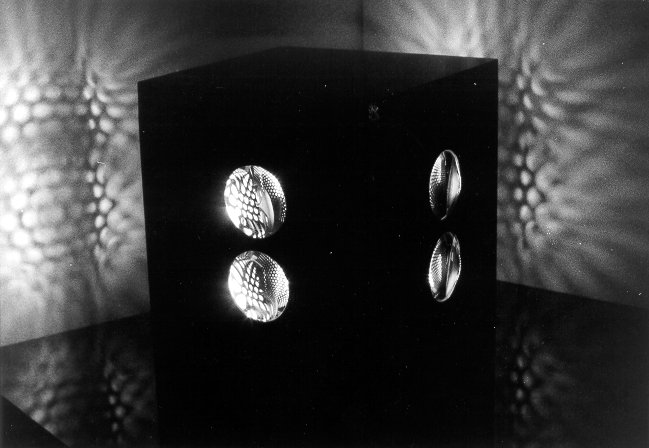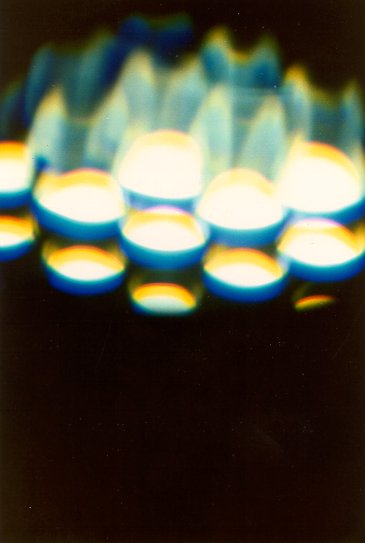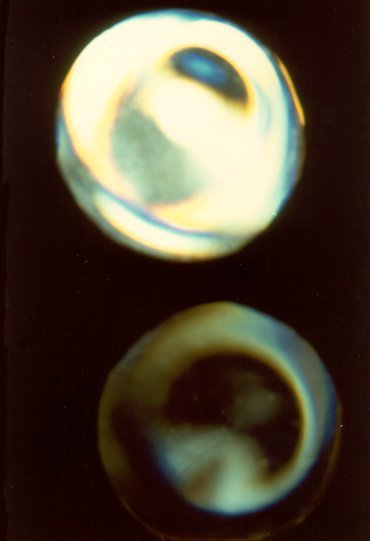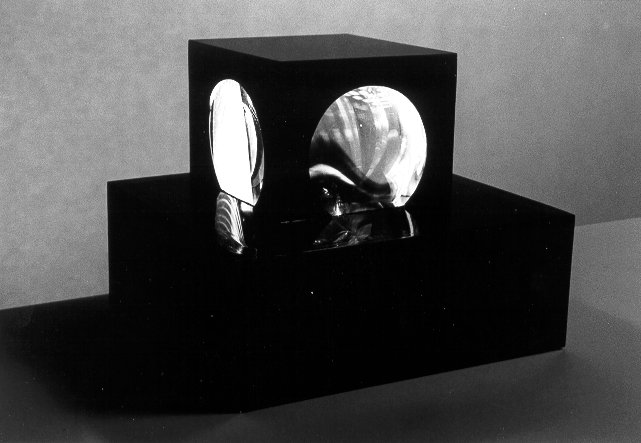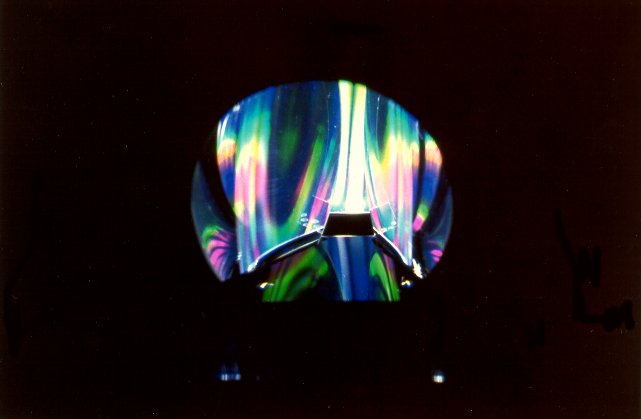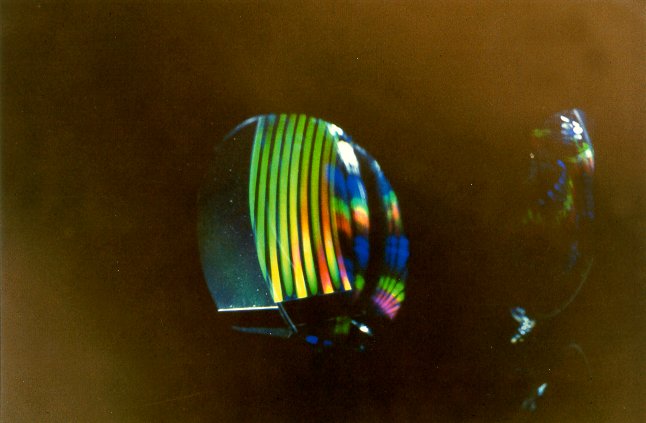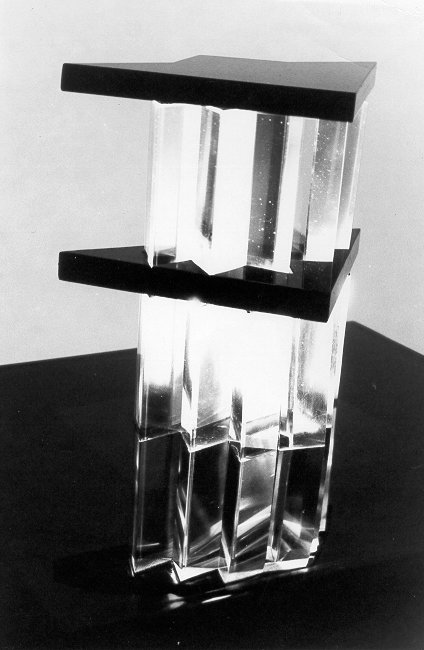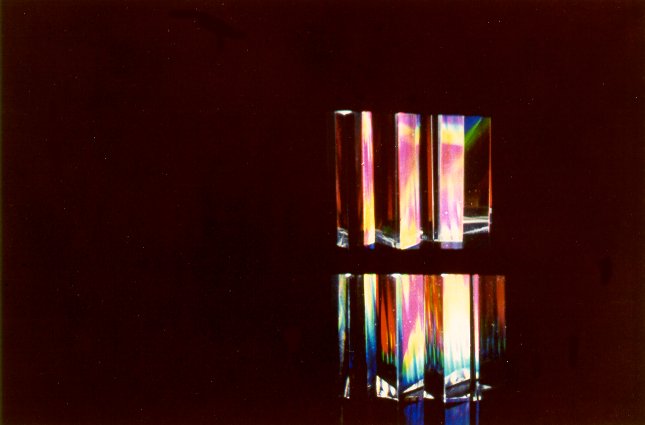|
Irene Rousseau Artist, Art Historian, MFA, Ph.D
Abstract
Introduction The interest in light has been present throughout the history of art. It appears in ancient architecture as a light and shadow play on walls and in cathedral windows made of stained glass. Light reflecting surfaces have been used by sculptors for centuries. The mosaicists in the Byzantine/Christian era used reflecting glass tesserae and broken color to dematerialize substance through the play of light. Their aim was to achieve a religious ideal of a transcendental space, standing outside of time. The Impressionists, centuries later, created form through the visual interplay of light and color. Both the Byzantine and the Impressionists wanted to dematerialize form to achieve an atmosphere, though the impetus for the creative expression served different ideals. Light became a vital ingredient in art. Rodin was interested in light and used light modulating surfaces for his sculptures. But it was not until the twentieth century that the behavior of light became a serious study in art. Moholy-Nagy and other artists of the Bauhaus, experimented with light as a new medium in art. They made transparent plastic constructions and illuminated them with light. The significance of their art was the isolation of light as an art medium. A new philosophy in art was born. Though the Bauhaus dates back to the 1920’s, it is only since 1960 that an active resurgence in the light medium has taken place. Constructivist art at the Bauhaus was not a technique or style, but a philosophy. Content and form of the work are one and the same. The subject of the work of art is the image itself. Yet, a constructive technique evolved as a means of defining space in structure. After 1960, a new generation of artists in Europe and in the United States began to work within the tradition of Constructivism. The fundamental principles of Constructivism were proclaimed in a document titled “The Realist Manifesto.” This is a “document of the highest importance in the history of the twentieth-century art.” [1] The Constructivists working with light made no attempt to consider color and transparency as properties of light, but by using light in their constructions, they were defining it as a part of form (structure). In fact, they renounced color as superfluous to form. They were interested in using transparent materials such as plastics to demonstrate simultaneous perception of different spatial locations. However, they did not consider the transparent qualities of light as a means of achieving spatial interaction and as a means of defining space by volume rather than by solid mass. Today’s technology and the method of constructing digitally is carrying many implications of the pioneers of light art to new conclusions. Light and transparency, especially as it relates to spatial interaction, has been of great interest to artists. The interest in light and transparency reflect modern society’s thirst for space. As Maholy-Nagy wrote: “The passion for transparencies is one of the most spectacular features of our time…The X ray pictures…give simultaneously the inside and outside, but also its inner structure…In my pictures I have tried to follow this space-time articulation by painting on waterclear tansparent plastics, introducing direct light effects…”[2] Through reflections superimposed on transparent materials fleeting images continuously fluctuate. One is able to perceive simultaneous superimposition of overlapping parts. Spaces fluctate, advance and recede… [3] Light and transparency are therefore used as the new materials in modern American sculpture. [4] to convey a floating sensation of spatial volumes and air voids. ”They conjure up a weightless existence, the Icarus dreams of the technical age.” [5] “Spatial experience,” sais Kepes, ”is intrinsically connected with the experience of light…space in a visual sense is light-space…the sensory modes of registering the modulated light, the various sensations of color, then become the means for spatial ordering of objects and events” [6]. Technology has focused attention on the investigation of light as a medium in art. The isolation of light as an artist’s medium has been of great interest to contemporary artists. Artists who have turned to the newer media in search for unexplored means of creativity have found that though the use of light as a medium is not new, the acceptance of it in art works is new. Sculpture has historically been modeled, perforated, suspend or kinetic. Today we sculpt with light and are aware of the space-time continuum and the necessity to explore new methods of creating art. The solid mass becomes a visually weightless volume of of relationships. Technology has provided the possibility to create works using lasers to make holograms using reflection and projection of light. The electronic excitation of phosphors in the TV picture tube has produced art displays using colored dots of light. Computer images using pixels now form digital mosaic art. But almost untouched are the possibilities of dispersion of light into spectral colors through refraction and diffraction. Spectral intensity variations of light have not been used as a means of creating sculptures whose spatial existence depends on the different wavelengths of color. Spectral color has not been used as a means of achieving interpenetration of space in sculpture, that is, a simultaneous perception of different spatial locations without the optical destruction of the common overlapping part. Interpenetration of space, also called transparency and light as a medium, are of major interest to contemporary artists. This artist is also exploring the sculptural problem of volume as perceived in terms of space-time and has used the transparent nature of light, as well as color color in an attempt to search for unexplored sources of creativity. The space-time continuum was expressed through visual movement (superimposition). This is achieved through creating sculptures whose existence is the visual interpenetration and immateriality of transparent spectral colors of light.
The earlier innovators and their heirs have led this artist to the proposed creative work as a logical continuation. The problem was to explore color and transparency as properties of light which, by the interpenetration of space in one’s visual perception, become sculpture. The creative significance of these sculptures was to prove the feasibility of the problem bridging science and art.
The Creative Process The creative work was conceived and constructed to explore light as sculpture based on the Constructivist concept of space. Three sculptures were planned using dispersion of white light into spectral colors by two different methods and the combination of these two. They are refraction and diffraction by transmission and reflection, respectively. The aim was to achieve spectral interpenetration of space in one’s visual perception, thereby enabling pure light energy to become sculptured space. To this end, transparent materials such as glass and plastics were used, in combination with the prisms, lenses, and diffraction gratings. The basic assumption was that light is optically transparent, and that light can be dispersed into spectral colors. Transparency and colors are properties of light. The conceptual interpretation of spatial interpenetration of light was represented by the use of tangible transparent materials and the intangible nature of light. The Constructivist qualities employed in the creative work were: structural clarity, geometry and technical precision. The inherent properties of materials were made to function as both the medium and the content and therefore determined the forms of the construction. To this end, the Constructivist concept of transparency, or simultaneity, was employed to achieve spatial interpenetration of form whose total structure can be apprehended immediately from its internal and external relationships. These numerous characteristics and interposed complexities, as well as the Constructivist criteria of directional linearity, depth as a plastic form of space, kinetic rhythm, and the use of the tone of the material as color, were utilized to achieve a constructed unitary whole. The creative work was based on a logical and poetical design in the use of the intrinsic qualities of the materials. The principle for construction depended on the critical angle at which light could be refracted or reflected, and then dispersed into spectral components. The amalgamation between the conceptual formulation and the visual perception was articulated into form. The immaterial concept was structured by reason, refined, clarified and formulated into a sensible cognition and poetic manifestation of a tangible, sensuous form.
Observations and significant materials as the work progressed were recorded in a log. The record included ideas, observations, sketches, problems and their solutions. The following summary of pertinent information from the log is included at this point to enable the reader to better understand the function of optical properties of the various materials used in the creative work.
Observations This brief ssumation describes the optical materials employed by the artist in her sculptures, to achieve intense, pure color and brilliancy of dispersed spectral light. In working with light, I observed how transparent materials whose capacity to act as a lens or prism could focus, refract, transmit and disperse light. By placing these transparent materials at specific distances or angles to the light source, they dispersed light into its component wavelengths or spectral colors, bending the violet color more than the red, hence spreading the violet over a larger area but compressing red towards the opposite end. Different substances produced a different spacing in their spectrum lines. The greater the density of the substances the greater was its dispersion. Various substances were used. Plastic has many advantages over glass. It is unbreakable, lightweight, and yet transparent. It is “soft” in comparison to glass, and can be cut, polished and glued easily, to accommodate structural changes in a sculpture. Yet, I chose the fragile medium of glass. Glass, above all, is more transparent, and the available optical materials are accurate. For example, the inclination of prism surfaces must be exact to refract light into spectral colors; the lens radii of curvature must be precise, to enable the light object on the axis to converge exactly at one point; rulings on a high quality diffraction grating must be equally spaced over the entire surface usually having 15,000 lines per inch, to enable maximum brightness of dispersed light [7]. Since plastic is a relatively new optical material as compared to glass, no such precision in the readily available items were found. Plastic surfaces mar easily, thereby destroying the transparent qualities of the material, and the spectral dispersion was dull in comparison to glass. Dispersion is the separation of complex white light into its different wavelengths of colors. One method of dispersion is refraction by transmission. A prism is used to bend the incoming point source of light, as it passes from the medium of air to glass. As light strikes the surfaces of a transparent prism, the prism causes light to bend into divergent wavelengths, e.g. violet, blue, green, yellow, orange e.g. red. These spectral colors are made visible by the prism which bends the shorter wavelength violet more than the longer wavelength red. A positive convex lends also refracts light into its component wavelengths. Chromatic aberration is a result of dispersion, described above. Due to chromatic aberration, there is no single focal point but a different one for each color. A different method to obtain dispersion is diffraction by reflection on a diffraction grating. As lightt strikes the parallel, equidistant and closely ruled lines of the highly polished surface of grating, it disperses through reflection into different wavelenghts leaving at different angles to form spectral colors. The grating unlike a prism or lens, produces several orders of the spectrum at the same time. The first order spectra lie on either side of the white central image. The neighboring second order spectra spread the light twice as much as the first. The higher the order, the wider the spectra but each order becomes dimmer than the previous one.
This brief summation describes the optical materials employed by the artist in her sculptures, to achieve intense, pure color and brilliancy of dispersed spectral light, which is impossible to conceive in any other way. Through the use of colorless materials and light, space becomes color as light sculptures space.
Sculpture I Refraction
In the first sculpture (Figure 1-3) light was dispersed through refraction by transmission,
and positive convex lenses were used to achieve this effect.
Figure 1: Refraction- sculpture
in lighted room
Figure 2: Refraction into spectral
colors in dark room
Figure 3: Refraction into spectral colors in dark room
The first step in the creation of this sculpture was to install four, 4-watt fluorescent lights, and affix them into a central core of light, radiating in all four directions. A perforated sheet was placed in front of each light to produce a pattern of light and dark, in the form of circles of light and stops of darkness. Two positive convex lenses were centered in front of each light source, and perforated sheet, allowing enough recess space to refract the point image of light, so that the resulting image from the lens at eye level is a swirl of spectral colors. A black, opaque, plastic box measuring 10”× 12” × 10” in length, height, and width, encases all materials and prevents arbitrary scattering of light. Only the transparent, illuminated lenses become visible in an otherwise dark room. Color dispersion through refraction by transmission is made visible when the electric light source is turned on. Since positive convex lenses are thicker in the center than at the edges, light rays are bent at a greater angle at the outermost edge, than in the middle, thereby resulting in a series of images, one for each component color of the light source, bringing violet light nearest the center of the lens and red at the outermost edges. At another viewpoint through the lens, the perforated sheet takes on a “honeycomb” effect of spectral colors. Dispersion being visible at the edges of greatest contrast, corresponding to the aperture and stops of the perforated sheet. The spherical nature of the lens causes the greatest barrel-like distortion or spherical aberration at the edges of the lens.
Brilliant spectral colors define space, optically creating a suspended volume of colored light, whose spectral planes simultaneously advance and recede in a visual “kinetic” rhythm. Visual immateriality, and interpenetration of space, is achieved through the use of lenses and the transparent nature of light. Light is the content, color and form of the sculpture.
Sculpture II Duffraction
The second sculpture (Figure 4-6) uses dispersion through diffraction by reflection.
To achieve this, a three-inch diffraction grating with 30,480 rulings per inch reflects
dispersed light onto five 4-1/2” diameter equiconvex lenses that surround the grating.
The materials are enclosed in a black plastic box measuring 4-1/2”10”9” in height,
width, and depth which is affixed on top of
a 4” × 10” × 9-1/2” box housing a 4-watt fluorescent light.
Figure 4: Diffraction - sculpture
in lighted room
Figure 5: Diffraction into spectral
colors in dark room
Figure 6: Diffraction into spectral colors in dark room
Light is directed onto the grating through perforations in a plastic sheet above the light. These circular apertures act as separate light sources and produce a corresponding image on the grating. The dispersed light is then reflected from the grating in a linear pattern of spectral orders ranging from violet nearest to the light source to red at the top of the grating. The visual image is confined to the two-dimensional surface on the grating, thereby producing a “painterly” effect. Lenses are used in conjunction with the grating to transform the “painterly “ image into a three-dimensional volume of colored light. While lenses can refract light, their primary purpose in this sculpture is to focus on different color regions on the grating and construct space with light. A magnified image of the spectral region appears as the lens is moved nearer to the grating. Distances therefore are important because they can greatly alter the visual effect. These color regions are reflected from the grating into the lenses, filling them with transparent spectral colors which optically interpenetrate each other’s space.
As in the first sculpture, light is the medium and the content.
Its transparent nature allows optical superimposition of spectral rhythms
and interpenetration of spatial planes. These continuously fluctuate, now the
closer, now the farther, in an optically “kinetic” multiplicity of spectral planes,
as the viewer focuses on the different overlapping spatial locations.
Sculpture III Refrection and Diffraction
The third sculpture
(Figure 7-8) is a combination of two different methods of dispersion brought
into a harmonious union and articulation of form.
Figure 6: Refraction and Diffraction
sculpture in lighted room
Figure 7: Refraction and Diffraction in dark room
The materials used in the creation of the work are two, three-inch reflection diffraction gratings, one placed directly above the other, and eleven, three-inch equilateral prisms. Six prisms surround the lower grating on three sides, and five prisms are positioned directly above the lower prisms in adjoining spaces between the prisms. These optical materials stand in a triangular formation on top of a black plastic rectangular box measuring 12” × 5” × 10” in width, height, and depth, which encases a 15-watt fluorescent light. Light is directed onto the gratings and onto the prisms through circular apertures, which act as separate light sources. A corresponding pattern on the gratings is in turn refracted and dispersed by the prisms. Prisms surrounding the gratings transform the “painterly” image into a sculptural volume of light, in a multiplicity of planes and superimposed linear spectral rhythms. Additional dispersion is brought about by these prisms which results in a phased, paused, repetitious, angular rhythm of spectral colors of light. The spectral lines form a series in which spacing and intensities produce a visual rhythm as they pass from one prism to the next. The prismatic effect is a fuzzy, linear, spectral rhythm superimposed on top of a clearly defined diffracted pattern of light. Additional dispersion at the edges of greatest contrast where aperture and stop meet is made visible at various prism surfaces surrounding the points of light. The coupling of the these two different types of spectral dispersion through diffraction by reflection and through refraction by transmission results in optically multiple rhythms and counterpoints. Their reciprocal action of spatial interpenetration enables color to structure space three-dimensionally. As in the previous two sculptures, the Constructivits concept of space was achieved by interpenetration of space through transparent materials and the transparent spectral colors of light. Similarly, the inherent properties of the materials are the content, color and form of this sculpture. The visual effect of the total construction results in an intricate system of color interaction of space. Spectral patterns are optically superimposed resulting in interpenetration of planes that simultaneously recede and advance in a new type of planar space articulation of light volumes. Light is intrinsic to the sculpture. Through light, space is modulated; without it, the sculpture is something else. The interest in interpenetration of space by light has arrived, and with it the problem of light as spectral space asserts itself for further exploration and development.
The reader should be aware that the sculptures went through many changes in order to
achieve certain effects that seem more aesthetically preferable based on Constructivist principles.
For example, black, opaque, polished plastic was chosen to contain the materials. The opaque material
prevents light from randomly scattering, and at the same time its polished black surface enhances the visual effect by echoing the dispersed spectral colors. The striking contrast between transparent, optical materials and black plastic is further accentuated, as color in darkness defines space. These industrial materials are devoid of an association with historically traditional sculptural materials. The material functions as the medium and the content of the sculpture. The content is now the form defining light as sculpture.
The Aesthetic Interpretation of Scientific Concepts The creative works are the conceptual poetical interpretation of spectral interpenetration of space in one’s visual perception. The transparent materials and the transparent nature of light enabled spaces to simultaneously interpenetrate each other without destroying the common overlapping part. Since spectral colors and transparency are a property of light, they visually interpenetrate each other’s space. The resulting multiple counterpoints of the linear, transparent, spectral rhythms in each sculpture were well defined. Color became structure, visually rendering it into an ethereal form of color-volume relationships as perceived in terms of space.
The ethereal sculpture on a conceptual level may be regarded as the representation of motion by the visual disintegration of material solidity by light. The element of time can be thought of as being a part of the work, in terms of changing spatial relationships from on moment to the next. Motion is brought about by confrontation with the viewer’s motion and exact position are measurable in duration, the element of time becomes a part of the work. All three light sculptures achieve Constructivist space in the conceptual formulation and the physical manifestation through the method of constructive technique.
Conclusion In regard to the use of light as a medium in art there are two major artistic findings:
Footnotes [1] H. H. Arnason, History of Modern Art. Painting-Sculpture-Architecture (New York:Harry N. Abrams, Inc., n.d.), p. 224 [2] Laszlo Moholy-Nagy, Vision in Motion (Chicago: Paul Theobald Co.,1946), p. 252 [3] Katherine Kuh, Art Has Many Faces (New York: Harpers, 1951), p. 128 [4] Jack Burnham, Beyond Modern Sculpture (New York: George Brazillier, 1970) p. 285 [5] Alfred Neumeyer, The search for Meaning in Modern Art (Engelwood Cliffs: Prentice-Hall Inc., 1964), p. 68 [6] Gyorgy Kepes, Language of Vision, p. 134 [7] Francis
A. Jenkins and Harvey
E White, Fundamentals of Optics, Third
edition (New York:McGraw-Hill Book Company, Inc., 1957). This book was
referred to for descriptions of optical phenomena for prisms, lenses and
diffraction gratings.
Bibliography Arnason, H. H., History of Modern Art, Painting-Sculpture-Architecture. New York: Harry N. Abrams, Inc., n.d. Bann, Stephen, ed. The documents of 20th-Century Art: The Tradition of Constructivism., Introductory Essay by the Editor. New York: The Viking Press, 1974. Burnham, Jack,Beyond Modern Sculpture. New York: George Brazillier Inc., 1970. Gabo, Naum, Gabo: Constructions, Sculpture, Drawings, Engravings. Introductory Essay Herberet Read and Leslie Martis London: Lund Humphries; Cambridge: Harvard University Press, 1957. Kepes, Gyorgy,Language of Vision. New York: Paul Theobold Co., 1944. Kuh, Katherine, Art has Many Faces. New York: Harpers, 1951. McLuhan, Marshall, Understanding Media. New york: McGraw Hill Book Co., 1960. Minnaert, M., The Nature of Light and Color on the Open Air. New York: Dover Inc., 1954 Moholy-Nagy, Laszlo, Vision in Motion. Chicago: Paul Theobald Co., 1946. Moholy-Nagy, Laszlo, The New Vision and Abstract of an Artist. New York: George Wittenborn, 1946. Moholy-Nagy, Sybil; Moholy–Nagy, Experiments in Totality. New York: Harper & Row, 1950. Rousseau, Irene, (unpublished notes, observations, and sculpturtes, copyrighted) Wingler, Hans,
The Bauhaus: Weimar, Dessau, Berlin, Chicago. Cabridge: M.I.T. Press,
1969
|
